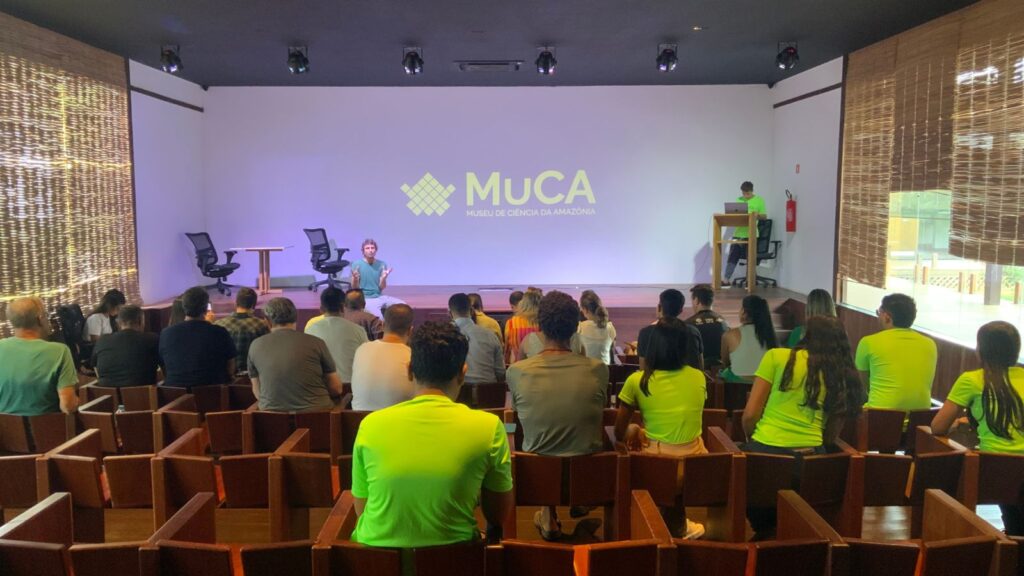The Amazon Science Museum (MuCA), located in Belterra, is preparing to be one of the key players in the decentralized programming of COP30, which will take place in November 2025 in Belém. With just a few months to go until the event,, MuCA is advancing efforts to establish Belterra as a strategic destination for the bioeconomy and community-based tourism. The museum has been receiving institutional missions, promoting cultural experiences, and creating opportunities for sustainable businesses and startups offering nature-based solutions.
Last week, Casa 1 Edenred-the headquarters of MuCA’s Center for Food Culture-hosted a mission from Sebrae Nacional. The delegation explored the museum’s proposed tourism circuit, designed to welcome international delegations and partners during COP30. The visit marked a significant step toward validating local infrastructure that combines immersive experiences in science, forest gastronomy, sustainable architecture, and community leadership. The training restaurant, supplied by Terra Preta’s agroforestry gardens, will be one of the official reception sites for representatives from various countries.
Additionally, in partnership with Sebrae, MuCA hosted a launch event for OkaHub-a program that will select and incubate national startups with sustainable, nature-based solutions for participation in COP30. The initiative aims to showcase the forest’s innovation potential through regenerative technologies, bio-inputs, cosmetics, food, and agroforestry systems that address global climate challenges.
As part of the programming, Sebrae also organized a fair in MuCA’s gardens featuring Amazonian artisans and producers. The fair displayed high-value products such as handcrafted objects, food, decorative items, and spices made by traditional communities and local creators. The curation emphasized the Amazon’s role as a cradle of sophistication, creativity, and territorial identity, with the potential to reach international markets.
One of the highlights of MuCA’s preparations for COP30 was the inauguration of a serpentarium, created in partnership with the Municipality of Belterra through its Department of Tourism and Environment (SEMTMA). The permanent exhibition, located in the museum’s agroforestry gardens, houses Amazonian snake species from a collection initiated by the Butantan Institute. The exhibit showcases the symbolic, cultural, and economic significance of these animals. Snakes are among the most culturally significant animals on the planet and hold deep connections to Amazonian myths and traditions. The curation of the space involved collaboration with a group of MuCA ambassadors, who gathered stories ranging from the myth of Sísio in the Lower Tapajós to tales of enchanted beings found throughout different territories of the forest.
The serpentarium-unprecedented in the region-is expected to become one of the Amazon’s main tourist attractions in the coming years, drawing visitors from Brazil and around the world. For Luiz Felipe Moura, MuCA’s coordinator, “the presence of snakes is not just scientific, but deeply cultural. They connect ancestral imagination with the contemporary challenges of bioeconomy and conservation.”
Through these actions, MuCA is positioning itself as a beacon of science, innovation, and sustainable tourism in the forest, anticipating trends expected to feature prominently at COP30. With over 60,000 visitors in the past year, Belterra is emerging as the “Brazilian Machu Picchu,” bringing together history, nature, and the future in a single territory.
MuCA’s partners who made all these initiatives possible include Edenred, Pacco, Volkswagen Truck & Bus, Everllence, Google, Transmissoras Brasileiras de Energia (EATE, ENTE, and ETEP), Taesa, Alupar, Sebrae, the Municipality of Belterra, Sectet-PA, the Government of Pará, IPHAN, the Ministry of Culture, the Ministry of Tourism, and the Federal Government.
